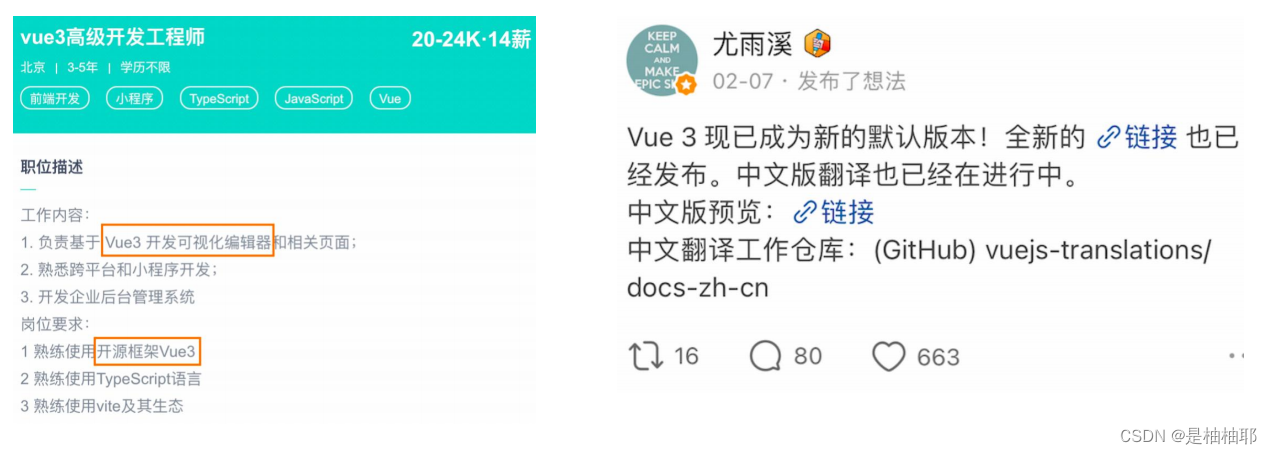一、为什么要学 Vue3
1.1 为什么要学 Vue3

1.2 Vue3的优势

1.3 Vue2 选项式 API vs Vue3 组合式API

Vue3 组合式API vs Vue2 选项式 API

二、create-vue搭建Vue3项目
2.1 认识 create-vue

2.2 使用create-vue创建项目
- 前提环境条件
已安装 16.0 或更高版本的 Node.js
node -v - 创建一个Vue应用
npm init vue@latest
这一指令将会安装并执行 create-vue

三、熟悉项目目录和关键文件
3.1 项目目录和关键文件
关键文件:
- vite.config.js - 项目的配置文件 基于vite的配置
- package.json - 项目包文件 核心依赖项变成了 Vue3.x 和 vite
- main.js - 入口文件 createApp函数创建应用实例
- app.vue - 根组件 SFC单文件组件 script - template - style
变化一:脚本script和模板template顺序调整
变化二:模板template不再要求唯一根元素
变化三:脚本script添加setup标识支持组合式API - index.html - 单页入口 提供id为app的挂载点

main.js
import './assets/main.css'// new Vue() 创建一个应用实例 => createApp()
// createRouter() createStore()
// 将创建实例进行了封装,保证每个实例的独立封闭性
import { createApp } from 'vue'
import App from './App.vue'// mount 设置挂载点 #app(id为app的盒子)
createApp(App).mount('#app')
App.vue
<!-- 加上 setup 允许在 script 中直接编写组合式API -->
<script setup>
import HelloWorld from './components/HelloWorld.vue'
import TheWelcome from './components/TheWelcome.vue'
</script><template><!-- 不再要求唯一根元素 --><header><img alt="Vue logo" class="logo" src="./assets/logo.svg" width="125" height="125" /><div class="wrapper"><HelloWorld msg="You did it!" /></div></header><main><TheWelcome /></main>
</template><style scoped>
header {line-height: 1.5;
}.logo {display: block;margin: 0 auto 2rem;
}@media (min-width: 1024px) {header {display: flex;place-items: center;padding-right: calc(var(--section-gap) / 2);}.logo {margin: 0 2rem 0 0;}header .wrapper {display: flex;place-items: flex-start;flex-wrap: wrap;}
}
</style>
四、组合式API - setup选项
4.1 setup选项的写法和执行时机
1.执行时机,比beforeCreated还要早
2.setup函数中,获取不到this(this是undefined)

App.vue
<script>
// setup
// 1.执行时机,比beforeCreated还要早
// 2.setup函数中,获取不到this(this是undefined)
export default {setup(){console.log('setup函数', this)},beforeCreate(){console.log('beforeCreate函数')}
}
</script><template><div>学习vue3</div>
</template>
运行结果

4.2 setup选项中写代码的特点

App.vue
<script>
// setup
// 1.执行时机,比beforeCreated还要早
// 2.setup函数中,获取不到this(this是undefined)
// 3.数据 和 函数,需要在 setup 最后 return ,才能模板中应用
// 问题: 每次都要return,好麻烦?
// 4.通过 setup 语法糖简化代码
export default {setup () {// console.log('setup函数', this)// 数据const message = 'hello Vue3'// 函数const logMessage = () => {console.log(message)}return {message,logMessage}},beforeCreate(){console.log('beforeCreate函数')}
}
</script><template><div>{{ message }}</div><button @click="logMessage">按钮</button>
</template>
数据 和 函数,需要在 setup 最后 return ,才能模板中应用
问题: 每次都要return,好麻烦?=> 语法糖
4.3 <script setup> 语法糖

App.vue
<script setup>
const message = 'this is message'
const logMessage = () => {console.log(message)
}
</script><template><div>{{ message }}</div><button @click="logMessage">按钮</button>
</template>
4.4 <script setup> 语法糖原理\

4.5 小结
- setup选项的执行时机?
beforeCreate钩子之前 自动执行 - setup写代码的特点是什么?
定义数据 + 函数 然后以对象方式return - <script setup>解决了什么问题?
经过语法糖的封装更简单的使用组合式API - setup中的this还指向组件实例吗?
指向undefined
五、组合式API - reactive和ref函数
脚本区加 “.value”
非脚本区不加 “.value”
5.1 reactive()
作用:接受对象类型数据的参数传入并返回一个响应式的对象
核心步骤:

- 从 vue 包中导入 reactive 函数
- 在 <script setup> 中执行 reactive 函数并传入类型为对象的初始值,并使用变量接收返回值
App.vue
<script setup>
// 1.reactive: 接收一个对象类型的数据,返回一个响应式的对象
import { reactive } from 'vue'
const state = reactive({count: 100
})
const setCount = () => {state.count++
}
</script><template><div>{{ state.count }}</div><button @click="setCount">按钮+1</button>
</template>
5.2 ref()
作用:接收简单类型或者对象类型的数据传入并返回一个响应式的对象
核心步骤:

- 从 vue 包中导入 ref 函数
- 在 <script setup> 中执行 ref 函数并传入初始值,使用变量接收 ref 函数的返回值
App.vue
<script setup>
// 1.reactive: 接收一个对象类型的数据,返回一个响应式的对象
// 问题: 如果是简单类型,怎么办呢?
// import { reactive } from 'vue'
// const state = reactive({
// count: 100
// })
// const setCount = () => {
// state.count++
// }// 2.ref: 接收简单类型 和 复杂类型, 返回一个响应式的对象
// 本质:是在原有传入数据的基础上,外层包了一层对象
// 底层,包成复杂类型之后,再借助 reactive 实现的响应式
// 注意点:
// 1.脚本中访问数据,需要通过 .value
// 2.在template中,value不需要加(帮我们扒了一层)// 推荐:以后在声明数据,统一用 ref => 统一了编码规范
import { ref } from 'vue'
const count = ref(0)
// console.log(count) //是个对象
const setCount = () => {count.value++
}
</script><template><div>{{ count }}</div><button @click="setCount">按钮+1</button>
</template>
5.3 小结
- reactive和ref函数的共同作用是什么 ?
用函数调用的方式生成响应式数据 - reactive vs ref ?
1.reactive不能处理简单类型的数据
2.ref参数类型支持更好但是必须通过.value访问修改
3.ref函数的内部实现依赖于reactive函数 - 在实际工作中推荐使用哪个?
推荐使用ref函数,更加灵活统一
六、组合式API - computed
6.1 computed计算属性函数
计算属性基本思想和Vue2的完全一致,组合式API下的计算属性只是修改了写法
核心步骤:
- 导入computed函数
- 执行函数 在回调参数中return基于响应式数据做计算的值,用变量接收

6.2 计算属性小案例

App.vue
<script setup>
// const 计算属性 = computed(() => {// return 计算返回的结果
// })import {computed, ref} from 'vue'// 声明数据
const list = ref([1, 2, 3, 4, 5, 6, 7, 8, 9])// 基于list派生一个计算属性,从list中过滤出 >2
const computedList = computed(() => {return list.value.filter(item => item > 2)
})// 定义一个修改数组的方法
const addFn = () => {list.value.push(666)
}</script><template><div><div>原始数据: {{ list }}</div><div>计算后的数据: {{ computedList }}</div><button @click="addFn" type="button">修改</button></div>
</template>
6.3 小结
最佳实践
- 计算属性中不应该有“副作用”
比如异步请求/修改dom - 避免直接修改计算属性的值
计算属性应该是只读的,特殊情况可以配置 get set
七、组合式API - watch
7.1 watch函数
作用: 侦听一个或者多个数据的变化,数据变化时执行回调函数
俩个额外参数:1. immediate(立即执行) 2. deep(深度侦听)
7.2 基础使用 - 侦听单个数据
- 导入watch函数
- 执行watch函数传入要侦听的响应式数据**(ref对象)**和回调函数

7.3 基础使用 - 侦听多个数据
说明:同时侦听多个响应式数据的变化,不管哪个数据变化都需要执行回调

App.vue
<script setup>
import { ref, watch } from 'vue'
const count = ref(0)
const nickname = ref('张三')const changeCount = () => {count.value++
}
const changeNickname = () => {nickname.value = '李四'
}// 1.监视单个数据的变化
// watch(ref对象, (newValue, oldValue) => {...})
// watch(count, (newValue, oldValue) => {
// console.log(newValue, oldValue)
// })// 2.监视多个数据的变化
// watch([ref对象1, ref对象2], (newArr, oldArr) => {...})
watch([count, nickname], (newArr, oldArr) => {console.log(newArr, oldArr)
})
</script><template><div>{{ count }}</div><button @click="changeCount">改数字</button><div>{{ nickname }}</div><button @click="changeNickname">改昵称</button>
</template>
7.4 immediate
说明:在侦听器创建时立即触发回调, 响应式数据变化之后继续执行回调

7.5 deep
默认机制:通过watch监听的ref对象默认是浅层侦听的,直接修改嵌套的对象属性不会触发回调执行,需要开启deep选项

App.vue
// 4.deep 深度监视,默认 watch 进行的是 浅层监视
// const ref1 = ref(简单类型) 可以直接监视
// const ref2 = ref(复杂类型) 监视不到复杂类型内部数据的变化
const userInfo = ref({name:'zs',age: 18
})
const setUserInfo = () => {// 修改了 userInfo.value ,修改了对象的地址,才能监视到// userInfo.value = {name: 'ls', age: 50}userInfo.value.age++
}
watch(userInfo, (newValue) => {console.log(newValue)
},{deep: true
})
</script>
<template><div>{{ userInfo }}</div><button @click="setUserInfo" type="button">修改userInfo</button>
</template>
7.6 精确侦听对象的某个属性
需求:在不开启deep的前提下,侦听age的变化,只有age变化时才执行回调

App.vue
// 5.对于对象中的属性, 进行监视
watch(() => userInfo.value.age, (newValue, oldValue) => {console.log(newValue, oldValue)
})
7.7 小结
- 作为watch函数的第一个参数,ref对象需要添加.value吗?
不需要,第一个参数就是传 ref 对象 - watch只能侦听单个数据吗?
单个 或者 多个 - 不开启deep,直接监视 复杂类型,修改属性 能触发回调吗?
不能,默认是浅层侦听 - 不开启deep,精确侦听对象的某个属性?
可以把第一个参数写成函数的写法,返回要监听的具体属性
八、组合式API - 生命周期函数
8.1 Vue3的生命周期API (选项式 VS 组合式)

8.2 生命周期函数基本使用
- 导入生命周期函数
- 执行生命周期函数 传入回调

8.3 执行多次
生命周期函数是可以执行多次的,多次执行时传入的回调会在时机成熟时依次执行
App.vue
<script setup>
import { onMounted } from 'vue'// beforeCreate 和 created 的相关代码
// 一律放在 setup 中执行
const getList = () => {console.log('发送请求')
}
// 一进入页面的请求
getList()// 如果有些代码需要在mounted生命周期中执行
onMounted(() => {console.log('mounted生命周期函数 - 逻辑1')
})// 写成函数的调用方式,可以多次调用,并不会冲突,而是按照顺序一次执行
onMounted(() => {console.log('mounted生命周期函数 - 逻辑2')
})
</script>
8.4 小结
- 组合式API中生命周期函数的格式是什么?
on + 生命周期名字 - 组合式API中可以使用onCreated吗?
没有这个钩子函数,直接写到setup中 - 组合式API中组件卸载完毕时执行哪个函数?
onUnmounted
九、组合式API - 父子通信
9.1 组合式API下的父传子
基本思想
- 父组件中给子组件绑定属性
- 子组件内部通过props选项接收

App.vue
<script setup>
// 父传子
// 1.给子组件,添加属性的方式传值
// 2.在子组件,通过props接收
import { ref } from 'vue'
import SonCom from '@/components/son-com.vue'const money = ref(100)
const getMoney = () => {money.value += 10
}</script><template><div><h3>父组件 - {{ money }}<button type="button" @click="getMoney">挣钱</button></h3><!-- 给子组件,添加属性的方式传值 --><SonCom car="宝马车" :money="money"></SonCom></div>
</template>components - son-com.vue
<script setup>
// 注意:由于写了 setup,所以无法直接配置 props 选项
// 所以: 此处需要借助于“编译器宏”函数接收子组件传递的数组
const props = defineProps({car: String,money: Number
})
console.log(props.car)
console.log(props.money)
</script><template><!-- 对于props传递过来的数据,模板中可以直接使用 --><div class="son">我是子组件 - {{ car }} - {{ money }}</div>
</template><style scoped>
.son {border: 1px solid #000;padding: 30px;
}</style>
9.2 组合式API下的父传子原理

9.3 组合式API下的子传父
基本思想
- 父组件中给子组件标签通过@绑定事件
- 子组件内部通过 emit 方法触发事件

App.vue
<script setup>
// 父传子
// 1.给子组件,添加属性的方式传值
// 2.在子组件,通过props接收// 子传父
// 1.在子组件内部,emit触发事件(编译器宏获取)
// 2.在父组件,通过 @ 监听
import { ref } from 'vue'
import SonCom from '@/components/son-com.vue'const money = ref(100)
const getMoney = () => {money.value += 10
}const changeFn= (newMoney) => {money.value = newMoney
}</script><template><div><h3>父组件 - {{ money }}<button type="button" @click="getMoney">挣钱</button></h3><!-- 给子组件,添加属性的方式传值 --><SonCom @changeMoney="changeFn" car="宝马车" :money="money"></SonCom></div>
</template>
components - son-com.vue
<script setup>
// 注意:由于写了 setup,所以无法直接配置 props 选项
// 所以: 此处需要借助于“编译器宏”函数接收子组件传递的数组
const props = defineProps({car: String,money: Number
})
console.log(props.car)
console.log(props.money)const emit = defineEmits(['changeMoney'])
const buy = () => {// 需要 emit 触发事件emit('changeMoney', 5)
}
</script><template><!-- 对于props传递过来的数据,模板中可以直接使用 --><div class="son">我是子组件 - {{ car }} - {{ money }}<button @click="buy">花钱</button></div>
</template><style scoped>
.son {border: 1px solid #000;padding: 30px;
}</style>
9.4 小结
- 父传子
- 父传子的过程中通过什么方式接收props?
defineProps( { 属性名:类型 } ) - setup语法糖中如何使用父组件传过来的数据?
const props = defineProps( { 属性名:类型 } )
props.xxx
- 子传父
- 子传父的过程中通过什么方式得到emit方法?
defineEmits( [‘事件名称’] ) - 怎么触发事件
emit(‘自定义事件名’, 参数)
十、组合式API - 模版引用
10.1 模板引用的概念
通过ref标识获取真实的dom对象或者组件实例对象

10.2 如何使用(以获取dom为例 组件同理)

10.3 defineExpose()
默认情况下在<script setup>语法糖下组件内部的属性和方法是不开放给父组件访问的,可以通过defineExpose编译宏指定哪些属性和方法允许访问

App.vue
<script setup>
import TestCom from '@/components/test-com.vue'
import { onMounted, ref } from 'vue'// 模版引用(可以获取dom, 也可以获取组件)
// 1.调用ref函数,生成一个ref对象
// 2.通过ref标识,进行绑定
// 3.通过ref对象.value即可访问到绑定的元素(必须渲染完成后,才能拿到)
const inp = ref(null)
// 生命周期钩子 onMounted
onMounted(() => {// console.log(inp.value)// inp.value.focus()
})const clickFn = () => {inp.value.focus()
}
// --------------------------------------
const testRef = ref(null)
const getCom = () => {console.log(testRef.value.count)testRef.value.sayHi()
}
</script><template><div><input ref="inp" type="text"><button @click="clickFn">点击让输入框聚焦</button></div><TestCom ref="testRef"></TestCom><button @click="getCom">获取组件</button>
</template>
components - test-com.vue
<script setup>
const count = 999
const sayHi = () => {console.log('打招呼')
}
defineExpose({count,sayHi
})
</script><template><div>我是用于测试的组件 - {{ count }}</div>
</template>
10.4 小结
- 获取模板引用的时机是什么?
组件挂载完毕 - defineExpose编译宏的作用是什么?
显式暴露组件内部的属性和方法
十一、组合式API - provide和inject
11.1 作用和场景
顶层组件向任意的底层组件传递数据和方法,实现跨层组件通信

11.2 跨层传递普通数据

11.3 跨层传递响应式数据

11.4 跨层传递方法

App.vue
<script setup>
import CenterCom from '@/components/center-com.vue'
import { provide, ref } from 'vue';// 1. 跨层传递普通数据
provide('theme-color', 'pink')
// 2.跨层传递响应式数据
const count = ref(100)
provide('count', count)setTimeout(() => {count.value = 500
},2000)// 3.跨层级传递函数 => 给子孙后代传递可以修改数据的函数
provide('changeCount', (newCount) => {count.value = newCount
})
</script><template><div><h1>我是顶层组件</h1><CenterCom></CenterCom></div>
</template>
components - center-com.vue
<script setup>
import BottomCom from './bottom-com.vue'</script><template><div><h2>我是中间组件</h2><BottomCom></BottomCom></div>
</template>
components - bottom-com.vue
<script setup>
import { inject } from 'vue';const themeColor = inject('theme-color')
const count = inject('count')
const changeCount = inject('changeCount')
const clickFn = () => {changeCount(1000)
}</script><template><div><h3>我是底层组件- {{ themeColor }} - {{ count }}</h3><button @click="clickFn">更新count</button></div>
</template>
11.5 需求解决思考

11.6 小结
- provide和inject的作用是什么?
跨层组件通信 - 如何在传递的过程中保持数据响应式?
第二个参数传递ref对象 - 底层组件想要通知顶层组件做修改,如何做?
传递方法,底层组件调用方法 - 一颗组件树中只有一个顶层或底层组件吗?
相对概念,存在多个顶层和底层的关系
十二、Vue3.3新特性-defineOptions
12.1 Vue3.3新特性-defineOptions
背景说明:
有<script setup> 之前,如果要定义 props, emits 可以轻而易举地添加一个与 setup 平级的属性。
但是用了 <script setup> 后,就没法这么干了 setup 属性已经没有了,自然无法添加与其平级的属性。
为了解决这一问题,引入了 defineProps 与 defineEmits 这两个宏。但这只解决了 props 与 emits 这两个属性。
如果我们要定义组件的 name 或其他自定义的属性,还是得回到最原始的用法——再添加一个普通的

src-view-login-index.vue
<script setup>
defineOptions({name: 'LoginIndex'
})</script><template><div>我是登录页</div>
</template>
十三、Vue3.3新特性-defineModel
13.1 Vue3 中的 v-model 和 defineModel

App.vue
<script setup>
import MyInput from '@/components/my-input.vue'
import { ref } from 'vue'
const txt = ref('123456')
</script><template><div><MyInput v-model="txt"></MyInput>{{ txt }}</div>
</template>
components - my-input.vue
<script setup>
import { defineModel } from 'vue'
const modelValue = defineModel()
</script><template><div><inputtype="text":value="modelValue"@input="e => modelValue = e.target.value"></div>
</template>
vite.config.js
import { fileURLToPath, URL } from 'node:url'import { defineConfig } from 'vite'
import vue from '@vitejs/plugin-vue'// https://vitejs.dev/config/
export default defineConfig({plugins: [//添加的部分vue({script: {defineModel: true}}),],resolve: {alias: {'@': fileURLToPath(new URL('./src', import.meta.url))}}
})
运行结果:






)

)

: 看看刚”转正“的条形码识别)
、HashSet)







)
